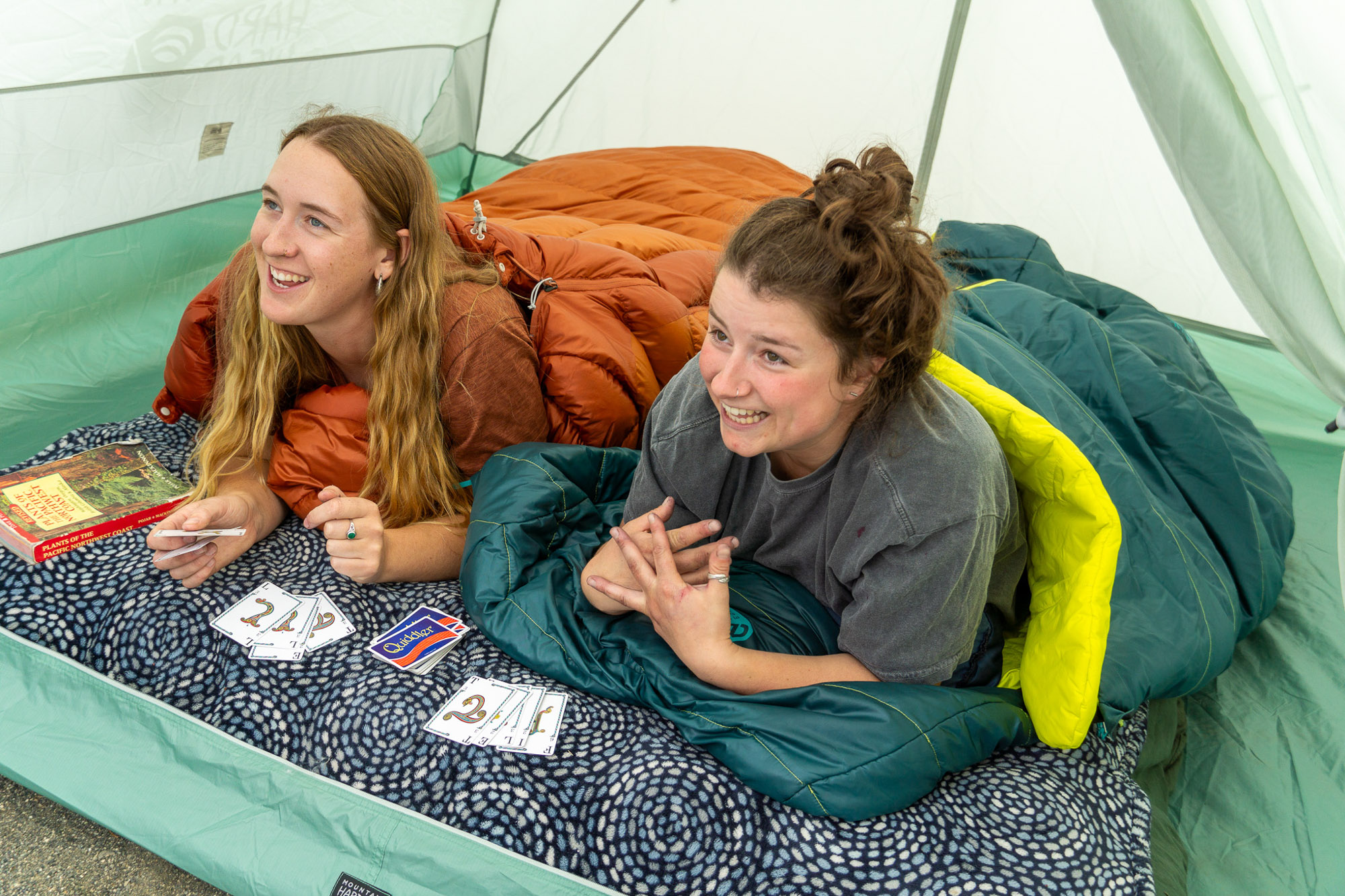While mummy bags are all the rage for backpacking, sometimes you need a bit more room to spread out. And where those bags prioritize weight and packability, the best camping sleeping bags are able to go fully luxe.
From the forests of the Pacific Northwest to the alpine of Colorado and the hills of Appalachia, we took to our tents and put bags to the test in order to find the top choices. Our testing team has collectively spent years sleeping under the stars using sleeping bags, and all of that knowledge went into our evaluations.
Whether you’re after the toss-and-turn-ready shape of the NEMO Jazz 30, the ultra-premium versatility of the Feathered Friends Penguin, or the wallet-friendly nature of the REI Co-op Siesta Hooded 20, we’ve got an option for most anyone. Tuck into our recommendations below.
Editor’s Note: We updated our Camping Sleeping Bags guide on August 11, 2025, to add the Sea to Summit Basecamp 15 — a super-comfortable and spacious down-filled bag, as well as the Teton Bridger, a solid rectangular option that slides in as a budget option. We also added additional rating attributes to every bag to further explain our testing process.
The Best Camping Sleeping Bags of 2025
Best Overall Sleeping Bag
9.1/10 Rating
Best Budget Camping Sleeping Bag
6.2/10 Rating
Best Premium Comfort Sleeping Bag
9.2/10 Rating
Best Sleeping Bag for Women
7.4/10 Rating
Best Double Sleeping Bag
7.0/10 Rating
Best Crossover for Camping and Backpacking
7.7/10 Rating
Best Classic Vibes Sleeping Bag
7.1/10 Rating
See more picks
Best Overall Sleeping Bag
-
Absolutely plush -
Capability to zip together -
Integrated sheet is quite soft -
Large hood can fit pillow from home
-
On the heavier and bulkier side -
Price
Best Budget Camping Sleeping Bag
-
Budget price -
Roomy headspace can accommodate a full-size pillow from home -
Affordable price for the quality and warmth -
Quilted design helps retain heat
-
Synthetic fill won’t compress as much as a natural down -
Zippers have tendency to snag
Best Sleeping Bag for Women
-
Women’s-specific fit has narrower shoulders and wider hips -
Wearable design for easy camp cruising -
Independent footbox zipper makes venting easy -
Vertical baffles in torso helps mitigate down shifting
-
Pricier than comparable bags out there
Best Double Sleeping Bag
-
Fully removable top cover -
Independent sheets for both sleepers -
Generous sleeping space
Best Crossover for Camping and Backpacking
-
NEMO’s spoon-shape bag is uber-comfortable, especially for those who toss and turn or side-sleep -
Updated Thermo Gill vents help modulate temperature -
Oversized draft collar is cozy to tuck into -
Smart manufacturing choices mean this bag is 100% recyclable at end-of-life
-
More of a backpacking bag, and might be more than you need for camping -
No footbox venting
Best Classic Vibes Sleeping Bag
-
Classic rectangle shape with some modern features -
Budget price -
Separate blanket is soft and cozy -
Flannel-lined interior
-
Not as thermally efficient as a snugger-fit bag -
Packed size is a bit large -
Blanket isn’t fully removable
Other Sleeping Bags to Catch Some Zs In
While the seven award-winning sleeping bags above are our go-to choices, there are literally hundreds more we’ve tested over the years, and a number of excellent alternative bags we’d have no problem recommending. Check out the eight below as great options for your next camping trip.
-
Very roomy fit with dual zippers for different venting options -
Quite warm for the shape with plenty of duck down -
Premium feature set -
Large hood can fit pillow from home
-
Large packed size and weight -
On the pricier side
-
Can zip with another Wawona bag to make a double bag -
Roomy shape works well for folks who toss and turn -
Upper fleece lining is soft on the face
-
Polyester insulation less warming than natural -
Lack of hood may be bothersome for colder sleepers
-
Burly cotton canvas outer resists dirt and debris -
Oversized zipper slides easily -
Soft flannel interior is super cozy -
Thick synthetic insulation is very resistant to moisture
-
Heavy at nearly 12 pounds -
Packed size is quite large, with little compression possible
-
Three separate zippers for maximum in ventilation options -
Roomy tapered rectangle fit -
650 FP down in a budget-minded bag -
Bottom shell fabric is a robust ripstop 45D nylon
-
Drawstring hood is a bit fussy to use -
Not quite as warm as stated
-
Roomy cut for tossing and turning -
Three different temperature ratings available -
Detachable camp blanket -
Pillow barn and pad sleeve
-
May be too wide/drafty for smaller campers -
No alternative sizes other than regular
-
Spacious rectangle cut -
Affordable price below $50 -
Durable polyester insulation won’t pack out quickly
-
Not as warm as rated for most campers -
Heavier weight -
Oversized for most sleeping pads
-
Classic rectangular shape -
Rugged canvas exterior -
Adds on a hood to wrangle your pillow -
Quite roomy for fully spreading out
-
Need to spend a bit more to get the real flannel lining -
Temperature ratings are a bit confusing -
Packed size is quite large
-
Simple and classic rectangle design -
Cheaper price for a down sleeping bag -
Zips together with another bag
-
Low fill weight down -
No alternative sizes offered
Sleeping Bag Comparison Chart
| Camping Sleeping Bag | Price | Available Temperature Ratings | Weight | Packed Volume | Insulation |
|---|---|---|---|---|---|
| NEMO Jazz 30 | $300 | 30°F | 6 lbs. | 16.1 L | 98% recycled polyester/2% polyester |
| REI Co-op Siesta Hooded 20 | $149 | 20°F | 5 lbs., 5 oz. | 17.7 L | Recycled polyester |
| Feathered Friends Penguin YF 20 | $560 | 10, 20 (tested), 30, 40°F | 2 lbs., 10.8 oz. | 17 L | 900+ FP goose down |
| Sea to Summit Women’s Ascent 30 | $429 | 15, 30°F (tested) | 1 lbs., 15.5 oz. | 6.8 L | 750+ fill-power Ultra-Dry down |
| Kelty Tru.Comfort 20 Doublewide |
$200 | 20°F | 9 lbs., 8 oz. | 65 L | Synthetic |
| NEMO Disco | $270 | 15 (tested), 30°F | 2 lbs., 11 oz. | 6.4 L | 650 fill-power duck down |
| Kelty Wayback 20 | $170 | 20°F | 6 lbs. | 37 L | Recycled Cloudloft Eco |
| Sea to Summit Basecamp 15 | $414 | 15°F | 4 lbs., 0.3 oz. | 14 L | 650 fill-power down |
| The North Face Wawona | $130 | 20°F (tested), 35°F | 4 lbs., 14.3 oz. | 27 L | 100% polyester fiber batting |
| ALPS OutdoorZ Redwood | $170 | -10 (tested), -25°F | 11 lbs., 8 oz. | 31 L | Synthetic |
| Mountain Hardwear Yawn Patrol | $275 | 15, 30°F (tested) | 2 lbs., 5.1 oz. | 15.6 L | 650 fill-power down |
| Big Agnes Echo Park | $200 | 0, 20 (tested), 35°F | 4 lbs., 12 oz. | 11.5 L | FireLine synthetic insulation |
| Coleman Brazos | $47 | 20 (tested), 30°F | 5 lbs. | 32 L | Synthetic |
| Teton Sports Bridger | $125 | -35, -20, 0 (tested), 20°F | 8 lbs., 12 oz. | 50 L | ‘SuperLoft Elite’ synthetic |
| Kelty Galactic 30 |
$170 | 30°F | 2 lbs., 11 oz. | 14 L | 550 fill-power down |
How We Tested the Best Camping Sleeping Bags
Our GearJunkie crew has slept in dozens of sleeping bags to bring you the best of the best. Every year, we saddle up and hit the woods to test the latest and greatest camping equipment. Reviewers from across the country converge to catch some Zzzs outdoors and put the best camping sleeping bags through a number of tests to prove their worth.
Our Testing Process and Testing Grounds
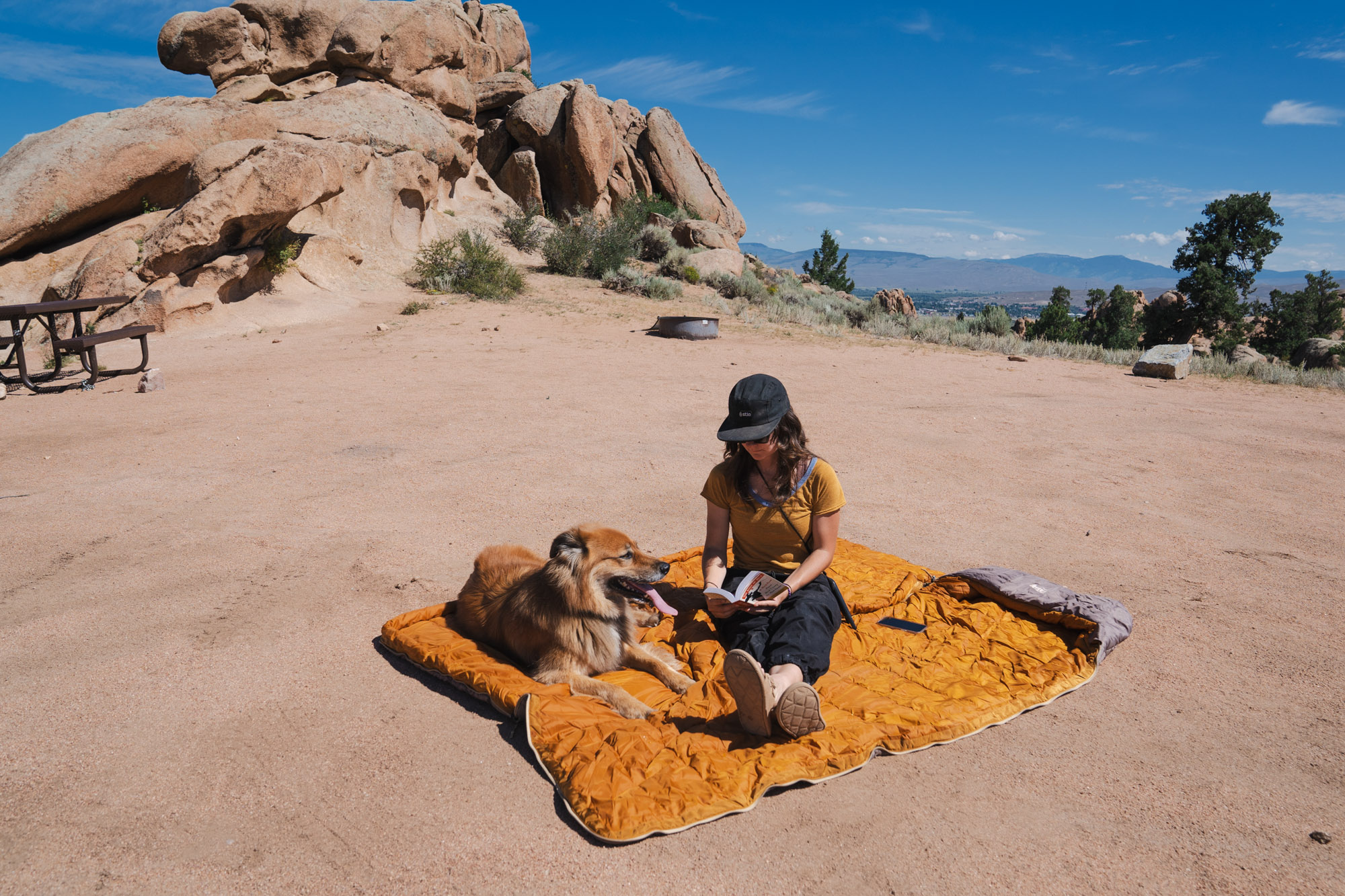
To conduct a proper sleeping bag testing regimen, we tested these bags in a variety of climates and conditions. From 35+ degree nights in a proper tent to mid-40s cozied up in a rooftop canopy, these bags were put through the wringer — and we tracked overnight temps to get an actual idea of relative warmth.
Furthermore, we also noted how well the bags fit our body frames and movement needs and whether they shifted much while we slept. Our lead tester, Meghan, requires much tossing and turning before she knocks out for the night, so being able to do this without the bag getting completely twisted was a major aspect she looked at. Once one tester has a solid feel for a bag, we cycle them out to get a consensus on comfort.
Our camp sleeping bag testing doesn’t end when the camping trip does, either. We dive into the hard numbers and break out the scales to test actual weights against manufacturer claims. We also ground-truth the estimated packed volumes by stuffing each sleeping bag into the same compression sack and measuring how tight we can get it. This gives us a good idea of which brands are accurate in its ratings and which might be fudging it a bit.
We also tested these bags’ relative moisture resistance. We focused on the areas of the bags most often dampened when camping: the footbox and the hoods. Each received a hearty dowsing from a spray bottle to simulate a real downpour (or leaky tent) and was monitored for water ingress.
Our Expert Testers


Our foray into camping sleeping bag testing began in 2021, when GearJunkie Editor-in-Chief Adam Ruggiero assembled a slate of bags and winnowed it down to a set of 11 essentials. Since then, we’ve seen a blizzard of new bags and technologies, and every year we have measured up the newest offerings against the old guard.
Current tester Meghan LaHatte has spent more time under the stars than not since she moved to Colorado in 2017. As an avid adventurer and lover of her beauty sleep, Meghan had no hesitation in helping tackle this buyer’s guide. From backpacking in the backcountry to classic car camping, she finds a lot of comfort in that cozy feeling of nestling into a plush sleeping bag.
Meghan tested out our most recent round of camping sleeping bags during the late spring and mid-summer in the Colorado Rockies. From nights spent in the dispersed camping areas of Crested Butte to the granite-encrusted deserts of Gunnison, Meghan made sure to evaluate these sleeping bags in more ways than one.
The final list of recommended sleeping bags is the combined result of thorough firsthand experience across the nation and various conditions. Beyond our field tests and personal experience, we determined the best sleeping bags based on metrics like reported warmth, packability, weight, material durability, and intended use. Ultimately, these bags serve a range of campers in their quest for ample quality sleep outdoors.
Our Sleeping Bag Rating System
We’ve chosen four rating attributes that we feel are most important when deciding on a camping sleeping bag. These metrics cover the range of what we’re looking for in a solid option and provide a detailed look at how we produce our overall bag ratings.
Warmth
A good camping sleeping bag has to be warm, and we consider this the most important attribute when rating a sleeping bag. We also consider the accuracy of the brand’s given temperature ratings when comparing our own findings, and look for a good consensus among our testers for a good rating here.
Comfort
Camping sleeping bags are often much wider and have more space to spread out than mummy bags, and we look for both the shape of the bag and the relative softness of the materials when rating them. We also consider how many different size options are offered when considering comfort, as well as any hoods, draft collars, or integrated sheets.
Feature Set
Camping sleeping bags will have more features than bags meant for backpacking. We look for integrated pockets, zipper systems that allow the bag to be worn, and specialty materials such as canvas or flannel when rating for feature set.
Packed Size
Because front-country camping is often close to home (or the car), the packed size of a sleeping bag isn’t as big of a deal, and we weigh it the least against the overall score. Synthetic bags tend to score lower on this metric, but so long as you can get it into the tent, we didn’t mark any bag down too low for packed size.
Buyer’s Guide: How to Choose a Camping Sleeping Bag
It’s worth spending time finding the right sleeping bag. After all, this is a piece of gear that will not only keep you comfortable at night but can easily last through years of use. And while there isn’t a single sleeping bag that’s best for every camper out there, this buyer’s guide will help identify the best bag for you.
We’ll note that this article is aimed at general camping. While some may be fine for backpacking, due to their size and weight, most are better suited to car camping or short hike-in scenarios. For longer trips in the backcountry, check out our review of the best backpacking sleeping bags.
Size and Shapes


No two people are shaped the same, and neither should their sleeping bags be. In searching out the best camping sleeping bags, we aimed for bags we could kick back in, toss, turn, and otherwise be as comfortable as possible. They typically took one of three shapes:
- Relaxed Mummy Bags: While the strict mummy bag is the sleeping bag shape of choice for many backpackers, there’s not much need on camping bags, and as such many soften the corners and let out the shape a bit for a more generous mummy cut that’s still pretty thermally efficient. The Sea to Summit Women’s Ascent is one of our favorite examples, and the Mountain Hardwear Yawn Patrol is more relaxed.
- Spoon-Shaped Bags: A decided specialty of NEMO, the hourglass shape of spoon bags bumps up the real estate around the knees and the torso, creating an oasis of space perfect for those a little more acrobatic during sleep. The NEMO Disco is a highlight here and offered up room to spin in our evenings in it.
- Rectangle Bags: The old stand-by: rectangle bags are simple and cut no corners to give you the maximum space to sprawl out in. Because of this, bags like the REI Co-op Siesta Hooded or Kelty Wayback won’t be as thermally efficient and might have some cold corners when pushed to their rating. Others still, like the ALPS OutdoorZ Redwood, simply have too much insulation for shape to ding their warmth.
- Double Bags: Sized, for two, double bags are most often rounded-off rectangles with enough space for a couple to snuggle down into. The Kelty Tru.Comfort Doublewide was our favorite of any available today, and had plenty of space for two to spread out.
For a long time, sleeping bag sizing was relegated to “Regular” and “Long” cuts, but recent years have introduced a number more options that better represent the bodies that sleep outdoors.
For instance, our testing team adored the four different sizes available on the REI Siesta, which mixed regular and long lengths with wide widths to offer up a spectrum of fits. Often, sleeping bag manufacturers will let you know the height ranges for its bags.


Women’s Specific Bags
While some manufacturers are moving away from gendered sleeping bag sizing, it’s important to know what you’re getting when you’re looking at a women’s-specific sleeping bag. These bags are very often wider at the hips and narrower at the shoulders, aiming to increase thermal comfort and eliminate dead space.
Women’s specific bags might also use a different insulation design, where more insulation is added to the core or feet to accommodate different needs. The Sea to Summit Women’s Ascent is one such bag, and our female testers lauded the changes compared to the men’s cut.
Warmth
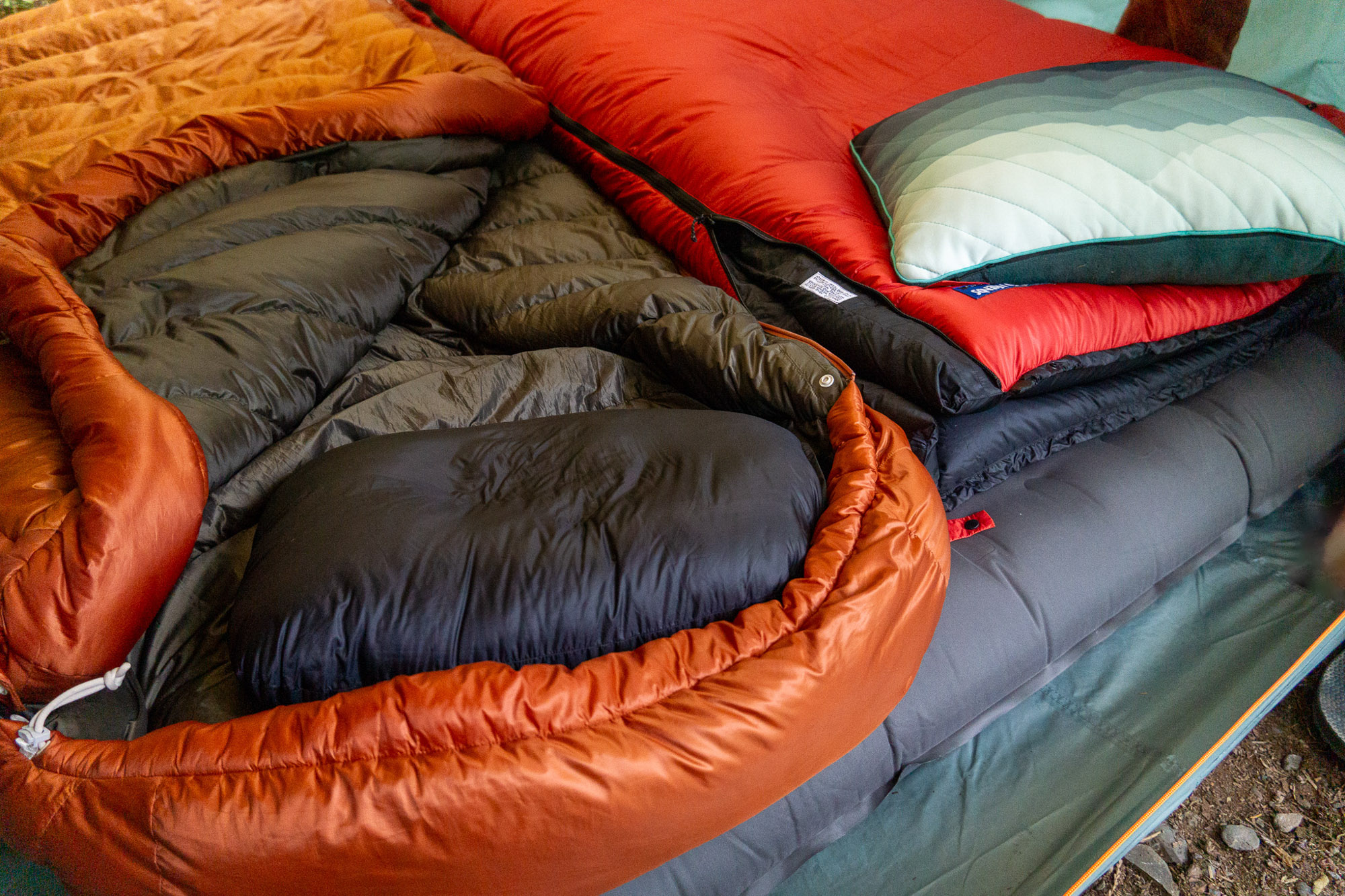

Sleeping bags come with a temperature rating, but depending on the person, a 20-degree bag might keep you cozy down to 20 degrees, or it might be more of a survival number. Because of this factor, we weighed warmth heavily in our testing, and we looked closely at ratings and how they panned out in real-world situations.
Bags often get rated for comfort — the lowest temperature a bag will keep an average cold sleeper comfortable — and lower limit — the lowest temperature for an average warm sleeper. The ratings are calculated using a person wearing long underwear and a pair of socks, and sleeping on an insulated pad.
In our own testing, the ALPS OutdoorZ Redwood -10 surprisingly came out on top in terms of warmth, owing to the massive amount of synthetic insulation it packs in. Following closely behind were the NEMO Disco and Feathered Friends Penguin YF bags, both down-filled but decidedly different shapes.
We find that bags rated between 20 and 30 degrees are ideal for most summer-season testing, and this is where the NEMO Jazz, Sea to Summit Women’s Ascent, Mountain Hardwear Yawn Patrol, and many others file in. Bags that are cut more generously, like the NEMO Disco, will work better in warm temps, while more mummy cuts are better to lower.
Insulation Options
Down Insulation


As the best insulator nature has come up with yet, down is able to insulate by trapping air in between the fibers and holding it there. It also has the ability to release moisture from within, meaning sleeping bags made with it are more breathable than those made with synthetic fill.
All down lands on a sort of continuum of efficiency that measures how much loft the fibers have. A higher fill power down will do the same insulating power of a higher amount of lesser down, meaning that a sleeping bag will need less of it to sport the same temperature rating. For example, a 32-degree sleeping bag made with 650 fill down will have more bulk and weight than that of a 32-degree bag made with 850 fill down.
The final metric to pay attention to in a down sleeping bag is the total fill amount. Knowing both numbers will give you an idea of how warm the sleeping bag is bound to be. Down does have its problems, and once damp it loses insulating power and is tough to dry. It also can be on the pricier side when compared to synthetic insulations, and shouldn’t be left compressed for long periods of time.
Synthetic Insulation


Synthetic fills are man-made polyester fibers that are designed to mimic the warmth-retention properties of down, but still provide some warmth once wet. These fibers are woven in different patterns to provide differing levels of warmth, breathability, and compressibility.
Synthetic fills are measured by the grams per meter squared (GSM) metric. This gives users an idea of how warm the sleeping bag will end up being. For example, a synthetic fill with a 2.5-ounce GSM can expect to provide a temperature rating of around 50 degrees Fahrenheit.
While there has been considerable improvement in synthetic fills over the years, we still haven’t been able to brew up a material that can match down in terms of weight-to-warmth ratio. Because of that, sleeping bags made with synthetic materials will need more insulation to provide the same amount of warmth. This will also mean that they often will be bulkier when packed. While our best overall bag, the NEMO Jazz 30, was cozy as all get-out, it also packs up to a substantial size.
It’s important to note that synthetic fibers are quite durable, but over time will compress down and lose the loft that they once had. Compared to down bags, however, they need a good bit less care in order to keep the sleeping bag rolling for a long time.
Packed Size
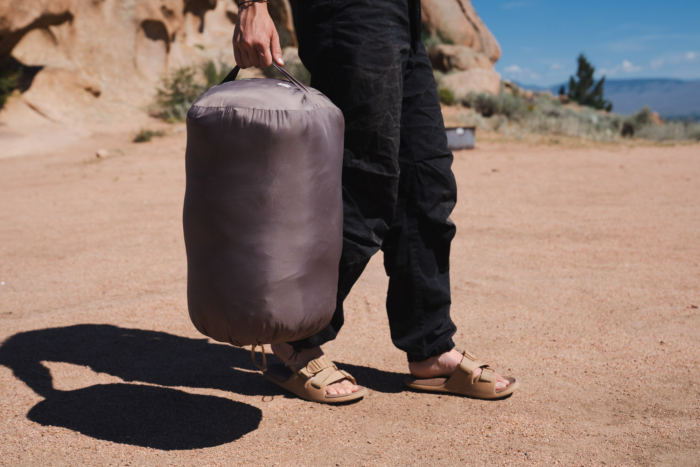

Packed size is of particular importance when backpacking, but isn’t as much of a concern for casual camping trips. But still, keeping things compact means more space in the back of the rig for snacks, and when choosing a sleeping bag that’ll be used for a bit of front and backcountry, packed size is much more important to pay attention to.
Anyone looking to minimize pack weight should consider a crossover backpacking/camping sleeping bag like the NEMO Disco or the Mountain Hardwear Yawn Patrol. These bags are often not quite as trim cut as a full-on backpacking bag, and make space at the feet and shoulders to accommodate more active sleepers.
More comfort-oriented bags with wider cuts won’t compress as well, and may even opt to forego the compression stuff sack entirely. The NEMO Jazz 30 travels in a spacious duffel-bag-like sack, and bags like the Kelty Wayback will roll up into themselves and secure with attached compression straps.
At the far end of the compressibility scale, the ALPS OutdoorZ Redwood has little use for a small packed size, and even less for your sympathies — this bag is large and in charge, and takes up the entire backseat of some sedans. But the comfort provided is well worth it, and the same can be said of the Kelty Tru.Comfort 20 Doublewide, which takes up an impressive 65 L of space in its laundry-bag-sized stuff sack.
Sleeping Bag Construction
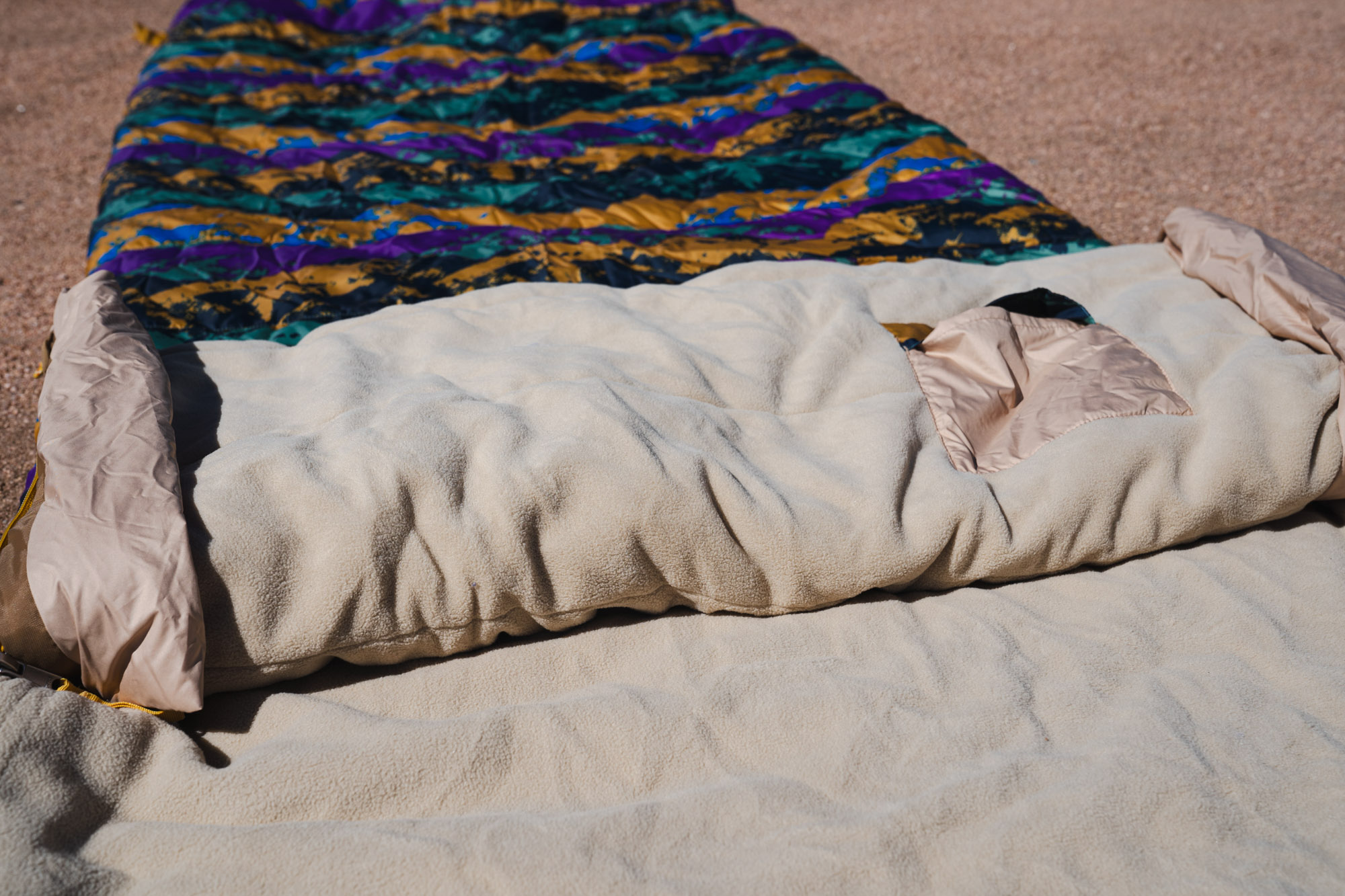

Shell and Liner Fabric
Most bags will use a ripstop material for the outer shell. Ripstop is a nylon or polyester fabric woven with heavier threads to resist abrasion and tearing. The unique construction of ripstop also allows it to remain fairly breathable.
As for bag liners, taffeta is among the most common choices. This is also a nylon or polyester material, but unlike the coarse feel of ripstop, taffeta has a pleasant, silky feel. And it is more breathable. This makes it an ideal choice for next-to-skin pieces. Some of the bags we reviewed, like the NEMO Jazz, have a removable insert sheet that’s washable and soft.
Zippers
Sleeping bag zippers may be seemingly simple, but can actually contribute heavily to a bag’s functionality and convenience. From LH and RH zippers to closeable vents, here are some different zipper aspects with camping sleeping bags:
- Left-Handed vs. Right-Handed Zippers: You’ll often see sleeping bags labeled as having left-handed (LH) or right-handed (RH) zippers when perusing options. Depending on your dominant hand, these configurations help with the ease of opening and closing the bag while lying down on your back.
- Full vs. ¾ Zippers: Another design aspect of sleeping bags is how much the zippers open. This often takes the form of being fully openable and closeable or at the ¾ length. A fully zippered sleeping bag is fantastic for doubling as a blanket at camp or if it is a relatively hot night and you need maximum ventilation. These bags tend to allow for more temperature customization since you can open them up all the way. The North Face Wawona and REI Siesta Hooded Bag can both fully unzip, allowing users to use them as a quilt or stick their feet out when the temps rise.
- Ventilation Zippers: As sleeping bag designers use more ingenuity, they are creating bags that allow for temperature customizations. Sometimes these venting options are footbox zippers for airflow to the lower extremities, while others, like the Mountain Hardwear Yawn Patrol, have multiple zippers for ventilation options. Another sleeping bag with added ventilation zippers is the Sea to Summit Women’s Ascent which has a side zip and footbox zip for added airflow. Even better, you can wear this sleeping bag like a snowsuit around camp, since it frees the arms and legs.
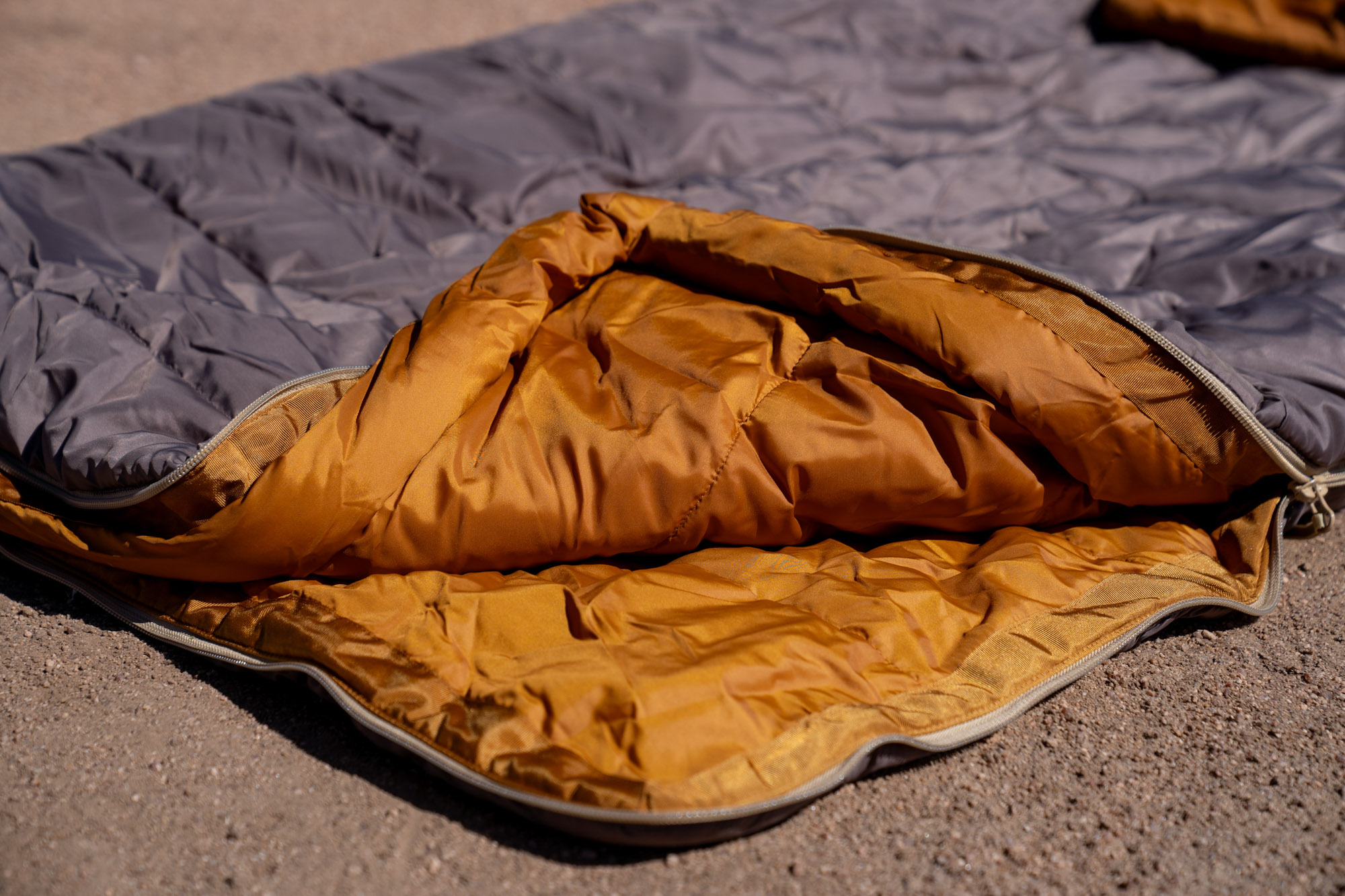

Pad Straps/Sleeves
To prevent slippage, many sleeping bags come with included sleeves or straps for attaching to a sleeping pad. While this is not a necessary feature to have on a sleeping bag, it can definitely be helpful if you tend to toss and turn throughout the night. Waking up on the ground next to your sleeping pad is never a fun feeling.
The NEMO Jazz 30 has two wide straps at the top and bottom of the sleeping bag for attaching it to a pad. These features will help keep you warm, as you can retain maximum insulation between yourself and the sleeping pad.
Furthermore, some of the sleeping bags listed also include a sleeve to keep your pillow stationary. If you’re car camping and have the space, a comfortable pillow is definitely a plus. The REI Co-op Siesta can fit a full-size pillow from home, so definitely consider that one if you seek this sort of feature.
Similar to liners, pad straps or sleeves are not required when it comes to a well-made sleeping bag. Some folks have success with just placing their pads inside the sleeping bag itself, but the shape and silhouette of your bag will need to be almost identical to your bag for this to work well.
Sleeping Bag Liners and Blankets


While they aren’t necessary, sleeping bag liners can help increase the warmth, cleanliness, and longevity of your sleeping bag, whether you’re backpacking remotely in the woods or heading out for a weekend of car camping with friends.
Sleeping bag liners can take the shape and form of being sewn into the actual sleeping bag or coming as a separate, thin sleeping sack. Because they are lightweight and less cumbersome than a sleeping bag, they are much easier to wash, thus making it easier to keep your sleeping bag in better shape without much maintenance or upkeep. The NEMO Jazz has a removable insert sheet that’s washable and soft. Not only is it breathable, but the taffeta fabric also provides a super comfortable surface when in use.
Some camping sleeping bags listed in this guide have sewn-in blankets that help retain heat and insulation within the bag itself. Similar to standalone liners, they can also make the sleeping experience much more comfortable due to that nice next-to-skin feel. We particularly enjoyed the flannel blanket on the Kelty Wayback, and the dual blankets on the Kelty Tru.Comfort Doublewide means we don’t have to fight over the covers.
Extra Features
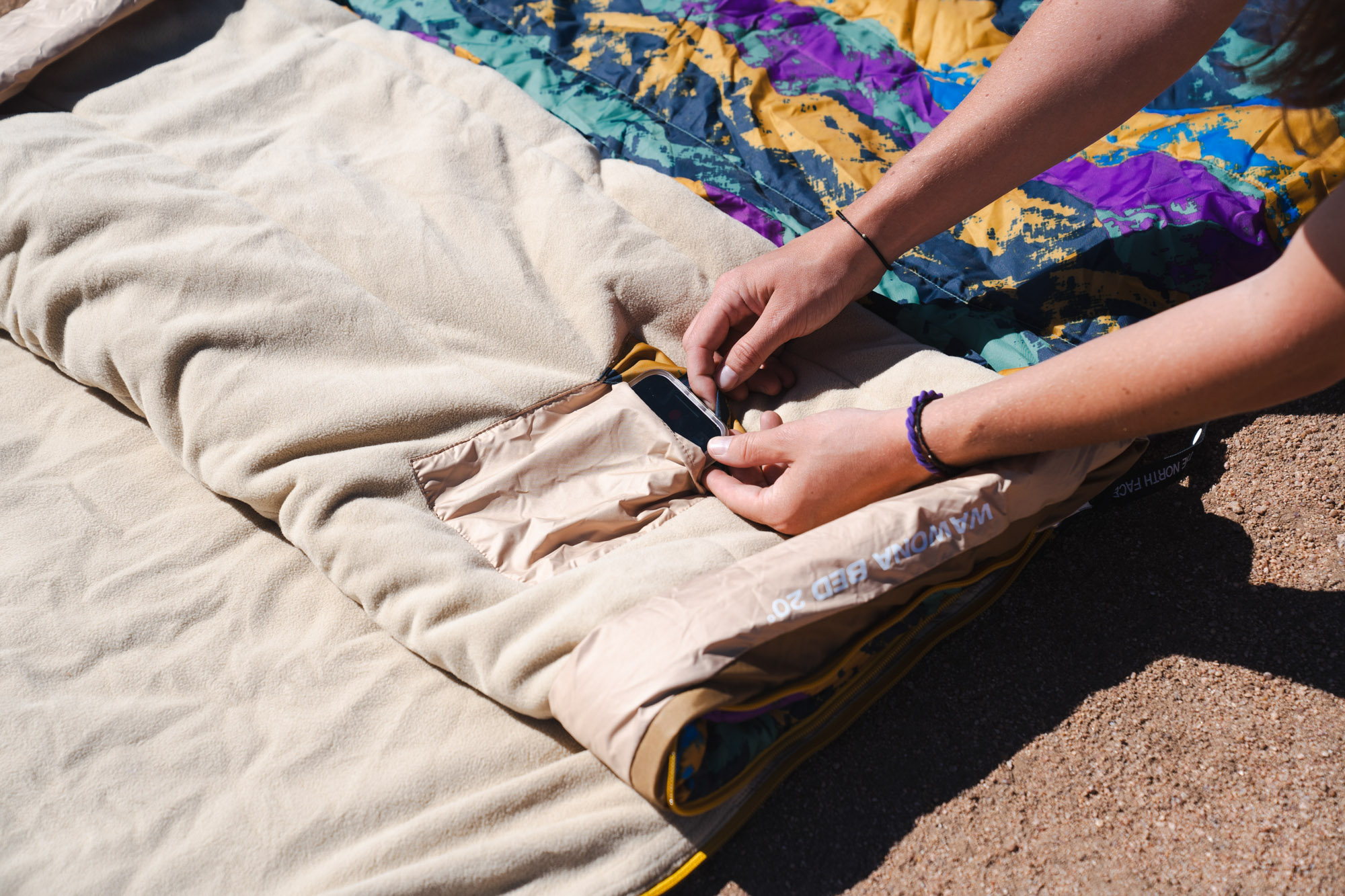

Camping sleeping bags have the luxury of retaining some of the niceties that backpacking sleeping bags have to leave behind, and we made sure to roll these considerations into our general impression as well. The top of the heap has to go to the NEMO Jazz, which piles on smart features such as an integrated and removable sheet, a pad sleeve, and a pillow pocket for wrangling your camp pillow in place.
Adjustable cinch cords on hoods are nearly universal on more comfort-mummy-shaped bags, and the better-designed versions will use two separate cords (often with different cord locks for midnight recognition) to adjust the upper and lower aperture openings. More modern functions like an internal phone pocket can be handy for keeping your phone warm all night, and we’re pleased that many bags are now jumping on this trend and incorporating them.
Price & Value


With a range of prices from $100 and all the way up to $550+ there’s plenty of variety in terms of what you get for your money when it comes to camping sleeping bags, but it generally comes down to a few important differences.
The first is going to be materials. Down versus synthetic will be the first big schism, with down-filled bags always asking for a more handsome sum compared to more affordable synthetic options. Sizing and design, too, will play a big part, with more mummy-style bags being cheaper and luxuriously wide bags going for more. Finally, smaller details, such as additional zippers for ventilation, integrated phone pockets, and pillow-sized hoods can nudge the price up as they are added on.
Budget
If this camping thing is all new to you, or you just don’t find yourself getting out all that much, it may not make sense to really splurge on a luxe sleeping bag (there’s plenty of other kit to get, after all). Budget camping sleeping bags will almost always be synthetic-filled, as it’s far cheaper to source, but don’t think that these bags are less for it. Synthetic bags fare far better with occasional moisture, and won’t lose loft as fast as down bags.
The REI Co-op Siesta Hooded 20 ($149) is an excellent option for those just getting into camping, as its a robust construction and available in a number of different sizes to accommodate any body type. Those looking for a more typical rectangular cut might also consider the Kelty Wayback ($149), which sports a classic shape and even tucks in a little luxury with the flannel interior.
Mid-Tier
If camping is one of your weekend go-tos, we’d suggest spending a bit more to get into a bag that will be ready to take on a wider variety of trips and conditions. Spending a bit more will also often mean you get a warmer-rated sleeping bag.
It will also open up the possibilities of getting into a down-filled sleeping bag, which compresses much more than synthetic bags and can be used for some backpacking as well. Down fills are most often around the 650 FP mark in this price range, where you’ll expect to spend between $200 and $350, depending on the temp rating.
The NEMO Jazz 30 ($300) is still our top pick for an excellent all-arounder, and its synthetic build is turbocharged with a number of different features that make it more versatile: a fully removable top cover, integrated sheet, sleeping pad sleeves, and a hood that’ll fit your pillow from home. The NEMO Disco ($320) is more of a hybrid design for backpacking, but it makes a killer camp bag as well.
Premium
For van lifers or those who find themselves bedding down in frontcountry camps more than they do at home, spending the extra cash to get a seriously nice sleeping bag can be a great investment into your sleep. Expect to pay north of $400 for the privilege, but for the money, you’ll be getting bags that use higher fill power downs and nicer shell fabrics such as Pertex materials.
The Sea to Summit Women’s Ascent 30 ($429) is a very nice bag, and is dialed in to be perfect for female bodies to nestle down into. Equally nice is the Feathered Friends Penguin YF 20 ($560), a camp bag from the boutique Seattle manufacturer that borrows from their knowledge in backpacking bags to trim out a seriously cozy camp bag that’ll even convert into a space for two.
Frequently Asked Questions
In general, every sleeping bag has a temperature rating — from -40 to 55 degrees Fahrenheit — that signifies the warmth of the bag. In the past, each brand conducted its own testing and assignment of temperature ratings. This made for a lot of variances across sleeping bags.
Luckily, most brands now use European Norm (EN) temperature ratings. Bags are therefore tested by a third party in internationally certified labs, using a series of standardized tests. This makes it much easier to compare bags, but not completely foolproof.
As noted above, a rating that may be comfortable for some could mean a shivering night of survival for others. So to make sense of sleeping bag ratings, it’s useful to know if you tend to sleep warm or cold.
Women generally sleep cooler and prefer a bag with a corresponding rating. So for the same camping trip, one person may prefer a 20-degree bag while another is completely comfortable in a 32-degree bag.
Hoping to snuggle up under the stars? Then it’s great to have two sleeping bags that zip together. The Kelty Galactic is a great budget-friendly option that zips together. Its rectangular shape also maximizes the room for two.
In general, mummy-style bags that share the same zipper type can be zipped together — although you’ll need one right- and one left-side zip bag.
And if you plan to always sleep together, it’s worth considering a double sleeping bag. These bags are designed for two and offer up the best features for a cuddly night’s sleep. We particularly like the Kelty Tru.Comfort 20 Doublewide.
Each material has pros and cons. Down, the plumage found underneath a waterfowl bird’s feathers, is loved for its warmth and its easy compressibility. Down sleeping bags tend to pack down small and light. But down can clump and stop insulating as well if it gets wet. Many companies treat down in order to avoid this, but don’t leave a down sleeping pad out in the pouring rain and expect anything less than a very soggy sleep.
Synthetic bags tend to be cheaper than down. It also dries quickly and insulates even when damp. But alas: synthetic is bulkier, packs less warmth at the same weight, and can lose insulating power slowly every time it’s compressed. Both types of bags have a time, place, person, and budget.
They’re nice to have, but by no means essential. Many amoung us have camped for over a decade, never used one, and is no worse for wear. We’re used to cramming into a backpacking tent where other people and pads keep movement to a minimum anyway. It really depends on how much you thrash around at night, and how big your tent is.


From packable sleeping pads to ultracomfortable air beds, we tested and found the best camping mattresses and sleeping pads to fit every adventure and budget.


We’ve found the best backpacking sleeping bags for every environment and budget, with top picks from Therm-a-Rest, Mountain Hardwear, NEMO, and more.
Read the full article here




